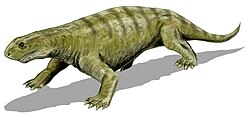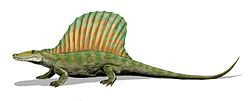| Ophiacodontidae Temporal range: Late Carboniferous to Early Permian | |
|---|---|
 | |
| Mounted skeleton of Ophiacodon retroversus in the American Museum of Natural History | |
| Scientific classification | |
| Kingdom: | Animalia |
| Phylum: | Chordata |
| Clade: | Synapsida |
| Clade: | Metopophora |
| Family: | † Ophiacodontidae Nopcsa, 1923 |
| Subgroups [1] | |
Ophiacodontidae is an extinct family of early eupelycosaurs from the Carboniferous and Permian. Archaeothyris , and Clepsydrops were among the earliest ophiacodontids, appearing in the Late Carboniferous. Ophiacodontids are among the most basal synapsids, an offshoot of the lineage which includes therapsids and their descendants, the mammals. The group became extinct by the Kungurian or the Roadian, [2] replaced by anomodonts, theriodonts, and the diapsid reptiles.






